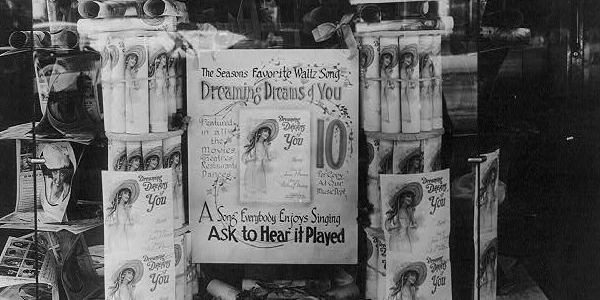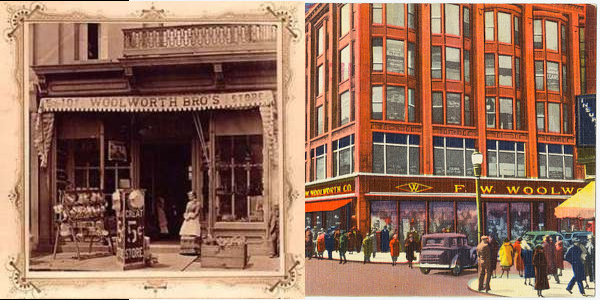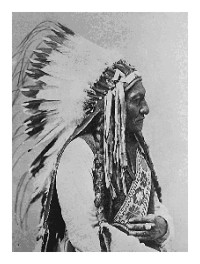Click here to Sponsor the page and how to reserve your ad.
-
Timeline
1879 - Detail
February 22, 1879 - The first five and dime store is opened in Utica, New York by Frank W. Woolworth with $300 of borrowed money, priced all items at five cents and pioneered the concept of fixed prices vs. haggling. It would fail weeks later. Woolworth opened a second store in Lancaster, Pennsylvania, including ten cent items, making the second store a success. With the assistance of brother Charles Sumner Woolworth and other syndicate partners, by their 1911 incorporation, they had over five hundred stores.

It was the first of its kind, a department store that would sell inexpensive goods to the public, at first at five cents apiece, and later, at ten cents, all at fixed prices, and allowing the customer to handle the merchandise. Until this time, most stores did not allow this, forcing the customer to hand a list to the store clerk who would gather the items. This was the thought of Frank W. Woolworth, a dry goods employee of Augsbury and Moore in Watertown, New York, who had a five cent table in their store. On February 22, 1879, with borrowed money from boss William Moore, Frank opened up his first store in Utica, New York, the "Woolworth's Great Five Cent Store." It failed in three months, but gave him enough money to pay back his boss.
What would push the idea to success was adding those ten cent items and choosing a good location. On June 19, 1879, Frank opened his second store in Lancaster, Pennsylvania. He used the same sign as that at Utica. It was a big success. Within one month, Frank decided that multiple locations seemed a great idea. His third store opened in Harrisburg on July 19, 1879 as 5c Woolworth Bro's Store, bringing brother Chester Sumner Woolworth on as manager. It closed, moved to York, then closed again, before finding another successful location in Scranton, Pennsylvania on November 6, 1880. With Chester Sumner Woolworth buying out his brother's share of that store, the Scranton location effectively became their first franchise.
Expansion, Demise, and Changes
It's the story of American entrepreneurship of the 19th and 20th century, particulary in the department store space. Like its predecessors, compatriots, and competitors (Sears, Penneys, and more), Woolworth's saw a steady rise to success, but used a slightly different initial model. Chester Sumner perfected his Scranton store before expanding into other locations while Frank opened his stores with greater speed. They both agreed to bring in more stores with partners, forming a syndicate of stores, albeit with different names. By 1904, there were six chains of stores in the syndicate. By November 5, 1909, Frank had his first store outside the United States in Liverpool, England. There were twelve in England by 1912, six hundred by 1934.
By 1912, Frank W. Woolworth had convinced the owners to incorporate into one entity, the F. W. Woolworth Company, merging all five hundred and ninety-six stores as of January 31, 1912 in a $65 million dollar merger. Frank brought in circa three hundred and twenty-seven, Charles Sumner fifteen, S.H. Knox one hundred and eleven, Fred M. Kirby ninety-six, Earle Charlton thirty-five, and William Moore two.
For most of the remainder of the twentieth century, F.W. Woolworth's was a staple in most mid to large towns in the United States and other nations. There were one thousand stores in America by 1917. The British subsidiary had one thousand stores by 1958. Woolworth built one of the first skyscrapers in New York City after the merger to house the corporate offices, seven hundred and ninety two feet high, the tallest building in the world until 1930. Frank would build the skyscraper with cash. By 1932, the chain had added another line of more expensive items, albeit only twenty cents. By 1935, they got rid of the price limits, but remained a discount store. By 1979, it was the largest retail department store chain in the world.
However, the changing landscape of competition, with additional department store chains such as K-Mart, Target, and Wal-Mart coming into the market in 1962, had started to have its impact. The publicity from the Civil Rights era sit-in in its Greensboro store on February 1, 1960 did not help in the public's eye. Those sit-ins would last for six months across the United States, reminding them of the original at the Woolworth's lunch counter in Greensboro, North Carolina.
Did You Know They Became Foot Locker?
In 1963, Woolworths began to diversify before the decline, buying Kinney Shoe Company, which would open a store called Foot Locker on September 12, 1974 in the Puente Hills Mall in the City of Industry, California, as well as other specialty stores, including Champs Sports, which is now part of the Foot Locker chain. However, as they changed their focus to the smaller chains, they forgot their core business. Nine hundred Woolworth department stores were closed in 1992. On October 15, 1993, Woolworths attempted a restructing plan to save the more than eight hundred general department stores in the chain by closing half of them. It did not work. On July 17, 1997, it closed its last remaining store in the United States. The British version of the chain closed in 2008. It had been independent since 1982.
Today, after several transitions, the former Woolworth's has been known as Foot Locker since 2001. It has about three thousand stores worldwide. There are still remnants of the Woolworth brand around the world, however. In Germany, an independent company has operated as F.W. Woolworth since 1998 and Woolworth Mexicana operates as a small special shop chain in Mexico. In Australia, a grocery store chain as Woolworth's operates, but has never been associated with the original Woolworth's company, and several smaller chains spun off from the British version exist in South Africa and Barbados.
Photo above: Window display of Woolworths, circa 1909/1932, National Photo Company. Courtesy Library of Congress. Image below: Montage of early Woolworth stores (left) second successful store in Scranton, 1880, unknown author; (right) portion of postcard of the Providence, Rhode Island store, 1930/1945, Rhode Island News Company Ticknor Quality Views. Both courtesy Wikipedia Commons. Info Source: http://www.woolworthsmuseum.co.uk/; Footlocker.com; companieshistory.com; Library of Congress; Wikipedia Commons.






